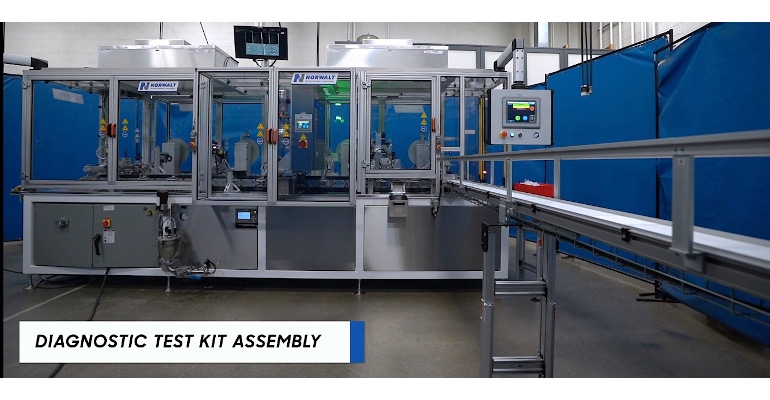From High Stakes to High Speed
Automation solutions stemming from the pandemic could reshape the medical device industry.
December 1, 2020

On a global scale, there was no playbook on how to overcome the challenges posed by COVID-19. But when the pandemic arrived in the United States, medical device companies were not prepared to mass produce at the level needed. From a manufacturing standpoint, combatting the virus meant implementing a system that had yet to exist. This was largely due to the fact that compared with other industries such as consumer goods and personal health, the medical device industry had yet to truly embrace automation as of early 2020. The urgent public health demand resulting from COVID-19 spurred a wave of progression within the industry as mechanical manufacturers rushed to develop new automation systems. The results that were ultimately attained represent a catalyst for change in the medical device industry. With the introduction of these enhanced automation strategies, medical device manufacturers face new opportunities to significantly increase product output while reducing long-term operational costs and maintenance spends.
Continuous Motion Maximizes Output While Reducing Operational Costs
According to a 2019 market research report published by MarketsandMarkets, the medical device contract manufacturing market is expected to grow from USD 55.0 billion in 2019 to USD 91.3 billion by 2024.1 This does not take into account the recent events brought by COVID-19, a clear example for why the medical industry needed to adapt and use automation to meet changing market demands.
To help the medical device industry quickly break free from its long-standing pattern of slow, low-volume production, machine builders pivoted to develop new automation systems in rapid time. Assembly speeds that were once as low as 15 parts per minute (PPM) increased to as high as 350 PPM with the implementation of these new machines.
While there are still questions surrounding Industry 4.0 and the role it will play in medical manufacturing, the need for high-volume, cost-efficient production is irrefutable. Nevertheless, many medical manufacturers have struggled to replace outdated indexing machines with advanced automation technology. For manufacturers, moving away from intermittent motion (i.e., stop-and-start operation) means breaking free from the cycle of slow speeds, limited volume, and inflated maintenance costs. Automation strategies simplify production layouts and increase efficiency on the factory floor. Given the speeds that these new systems needed to achieve, relying on intermittent motion would have added complexity to the production line because it would require more manpower and QA systems to monitor multiple feeds. By utilizing continuous motion, these new systems can operate in a singular feed as opposed to multiple, thus simplifying production processes and reducing long-term labor and maintenance costs.
While these types of projects occurred across the nation during the height of the pandemic, the results extend far beyond COVID-19. Now, when manufacturers need to mass produce other medical devices such as influenza tests or strep tests, they can meet these high-volume demands while reducing their operational costs. This creates an entirely new era of potential for the industry as manufacturers can now produce a wide range of medical device products in rapid time.
Increasing Safety as Much as Speed
In addition to the high-speed benefits, automation satisfies a number of safety and sanitation concerns that are inherent to the medical device industry. Medical Plastic News highlights this point, arguing that due to strict industry regulations:
Device manufacturers are under pressure to reproduce the same product, under the same stringent conditions, with little downtime...Robotics and automation offer manufacturers modular systems that promote efficiency and workflow. Motion control systems help production lines assemble and move medical devices in a flexible workspace.2
With the implementation of high-speed automation, manufacturers can minimize the amount of human-to-product contact and better reduce contamination risks. It also reduces the likelihood of human error in an already highly regulated industry where public health is always on the line. It is important to recognize the role that automation plays in increasing safety and preventing costly mistakes that would otherwise negate the benefits of high-speed production.
Newfound Potential Within a Growing and Evolving Market
With these automation strategies already in motion, manufacturers can replicate them to produce other test kits and medical devices in high quantities. Such improvements can transform the future of medical manufacturing and accelerate new changes that many have already predicted, such as instant-result testing in physicians’ offices and at-home test kits. Whatever the future holds for the medical device industry, it is clear that automated technology has a rightful place in it and can prove mutually beneficial for both manufacturers and consumers alike.
References
MarketsandMarkets. “Medical Device Contract Manufacturing Market Worth $91.3 Billion by 2024 - Exclusive Report by MarketsandMarkets™.” PR Newswire: news distribution, targeting and monitoring, May 23, 2019. https://www.prnewswire.com/news-releases/medical-device-contract-manufacturing-market-worth-91-3-billion-by-2024--exclusive-report-by-marketsandmarkets-300855769.html.
Armstrong, Reece. “How Robots Are Revolutionising Medical Device Manufacturing.” Medical Plastics News, August 7, 2018. https://www.medicalplasticsnews.com/news/opinion/how-robots-are-revolutionising-medical-device-manufacturing/.
About the Author(s)
You May Also Like


.jpg?width=300&auto=webp&quality=80&disable=upscale)


